 |
| From The Blue Beetle Faces the Destroyer of Heroes, Blue Beetle, Vol. 1, No. 5, November 1968, Charlton Comics Group, Derby Connecticut. |
It’s Memorial Day. I’m not up to anything particularly deep about the meaning or execution of art. Instead, I’m giving you Steve Ditko being deep about the meaning of art and heroism: selected panels from “The Blue Beetle Faces the Destroyer of Heroes,” Blue Beetle, Vol. 1, No. 5, November 1968, Charlton Comics Group, Derby Connecticut. Script by D.C. Glanzman, Penciled by Steve Ditko, Inked by Steve Ditko.
You want to read the whole thing? I recommend you hunt down the comic book, since it’s still under copyright. But, pretty much, you can see where he’s going with this.
 |
| From The Blue Beetle Faces the Destroyer of Heroes, Blue Beetle, Vol. 1, No. 5, November 1968, Charlton Comics Group, Derby Connecticut. |
In 1968, clothing was a better indication of social status than it is today. But oddly enough, as the elite has become more nihilistic in America, their clothing has gotten rattier. Coincidence?
 |
| From The Blue Beetle Faces the Destroyer of Heroes, Blue Beetle, Vol. 1, No. 5, November 1968, Charlton Comics Group, Derby Connecticut. |
I don’t think I paint women in bondage because I’m celebrating their nature, but rather I’m celebrating their ability to endure. But he has a point here:
 |
| From The Blue Beetle Faces the Destroyer of Heroes, Blue Beetle, Vol. 1, No. 5, November 1968, Charlton Comics Group, Derby Connecticut. |
And I’m just happy to see this type of cultural critic lampooned. He never changes.
 |
| From The Blue Beetle Faces the Destroyer of Heroes, Blue Beetle, Vol. 1, No. 5, November 1968, Charlton Comics Group, Derby Connecticut. |
Ditko comes perilously close to the idea that there is a spiritual battle being fought all around us, one we cannot see unless we have “spiritual eyes.” I suppose that is a kind of superpower.
 |
| From The Blue Beetle Faces the Destroyer of Heroes, Blue Beetle, Vol. 1, No. 5, November 1968, Charlton Comics Group, Derby Connecticut. |
This makes me want to stick to landscape painting.
 |
| From The Blue Beetle Faces the Destroyer of Heroes, Blue Beetle, Vol. 1, No. 5, November 1968, Charlton Comics Group, Derby Connecticut. |
This was definitely the 20th century battle of viewpoints:
 |
| From The Blue Beetle Faces the Destroyer of Heroes, Blue Beetle, Vol. 1, No. 5, November 1968, Charlton Comics Group, Derby Connecticut. |
Speaking of heroes, I’ve been thinking all day about
ArmyPfc. Dwane A. Covert Jr. of Tonawanda, NY, killed in Operation Iraqi Freedom on November 3, 2007.
We are involved in an endless war that seems to have few casualties, so it’s easy to forget the ones our nation has suffered. But a moment to remember the men and women who have fallen in the quest to keep us safe does not come amiss.
August and September are sold out for my workshop at Lakewatch Manor in Rockland, ME. Join us in June, July and October, but please hurry! Check here for more information.

So, was this a buried comic found during Memorial Day cleaning? When purchased? Are you a closet comic book collector?
Fun read.
(wrong phase- but on the politics of art)
It is really easy to believe that one can do nothing alone, because there is a need for people to see our achievements in a group setting. The achievements that people cannot see do not count for anything(Which I don't believe, but is true in the sense of some "worlds"). That, and to do things alone is an undesirable human condition.
For example: Eating alone in a restaurant would be seen as daft, no matter the context.
(Not that eating alone is undesirable, so much as, it is unacceptable to eat alone.)
Also, there are a lot of gender issues revolved around the nature of the art world where women are seen as inferior beings. Women are not inferior, but that is the message that is shown to women every day. We then quickly cloak ourselves with absurd "hardships" in order to stand next to men. Billboards say to us, we must be objects before the eyes of men in order to have value- innate goodness is not good enough. To be an iconoclast is to be an alien amongst the crowd. Interestingly, to be different is unacceptable. The problem is- in a dense population, this thought permeates through the fabric of society very quickly.
Now, in this comic the crazy modern artist is deluded because he doesn't know how to celebrate the success of others. Instead he aims to show human atrocity which doesn't empower anyone,and his goal is to tear people down.
In terms of the critic- he is just too senile for his own good.
To clarify my ramblings:
The first sentence doesn't match the second half of the sentence.
First half is in reference to art world and the second is in reaction to a comment that a male artist made about female artists and the way the works of female artists are sold.
– of the third paragraph.
Purchased when new, and not I but my husband is the closet comic collector…